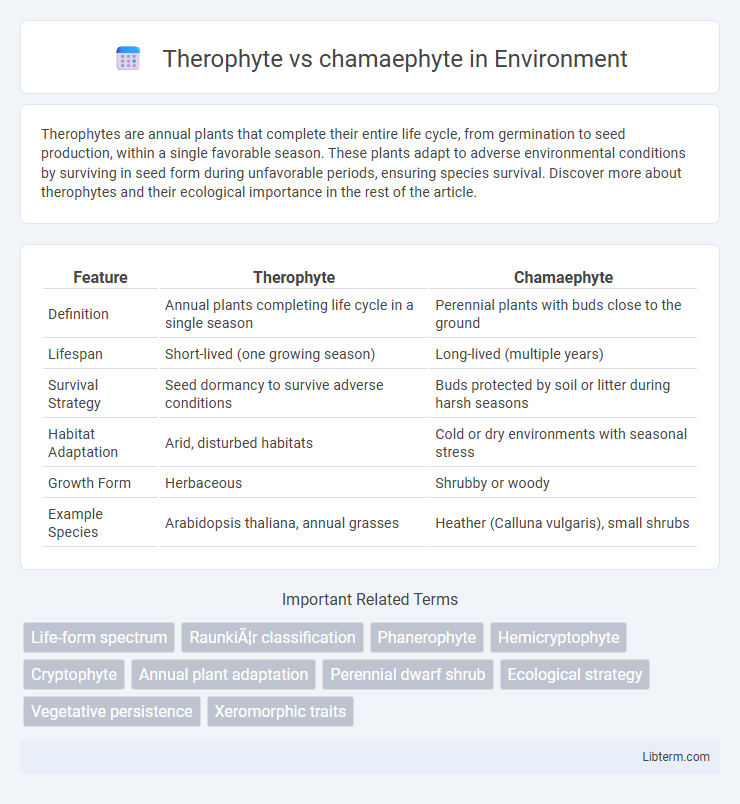Therophytes are annual plants that complete their entire life cycle, from germination to seed production, within a single favorable season. These plants adapt to adverse environmental conditions by surviving in seed form during unfavorable periods, ensuring species survival. Discover more about therophytes and their ecological importance in the rest of the article.
Table of Comparison
| Feature | Therophyte | Chamaephyte |
|---|---|---|
| Definition | Annual plants completing life cycle in a single season | Perennial plants with buds close to the ground |
| Lifespan | Short-lived (one growing season) | Long-lived (multiple years) |
| Survival Strategy | Seed dormancy to survive adverse conditions | Buds protected by soil or litter during harsh seasons |
| Habitat Adaptation | Arid, disturbed habitats | Cold or dry environments with seasonal stress |
| Growth Form | Herbaceous | Shrubby or woody |
| Example Species | Arabidopsis thaliana, annual grasses | Heather (Calluna vulgaris), small shrubs |
Introduction to Plant Life-Forms
Therophytes complete their entire life cycle rapidly within a single favorable season, surviving adverse conditions as seeds, making them common in arid and disturbed habitats. Chamaephytes are perennial plants with buds located close to the ground, typically 25 cm or less above the soil surface, which provide protection during unfavorable seasons and allow regrowth. These two life-forms represent adaptive strategies within Raunkiaer's Plant Life-Forms system, highlighting variations in plant survival and reproduction in response to environmental stresses.
Defining Therophytes: Key Characteristics
Therophytes are annual plants that complete their entire life cycle--from germination to seed production--within a single growing season, often adapted to survive unfavorable conditions through seeds. Characterized by their absence of persistent vegetative structures during dormancy, they rely on seed banks for regeneration rather than perennating organs. In contrast, chamaephytes maintain perennial shoots close to the ground, allowing them to endure adverse seasons with existing buds protected by soil or leaf litter.
Understanding Chamaephytes: Essential Traits
Chamaephytes are perennial plants with buds located close to the ground, usually no more than 25 cm above the soil surface, which allows them to survive harsh environmental conditions by minimizing exposure to wind and frost. These plants possess woody or semi-woody stems that persist year-round, enabling rapid regrowth after damage and contributing to their resilience in arid or cold climates. In contrast, therophytes complete their life cycle within a single growing season, relying on seed production for survival rather than perennial structures.
Ecological Roles of Therophytes
Therophytes, as annual plants completing their life cycle in a single season, play a crucial role in ecological succession by rapidly colonizing disturbed or barren soils, thus preventing erosion and enhancing soil fertility. Their short life cycle allows them to exploit transient favorable conditions, supporting biodiversity by providing food and habitat for various insects and microorganisms. In contrast, chamaephytes, with their perennial woody structures close to the ground, contribute to long-term habitat stability and protection against environmental stressors.
Chamaephytes in Plant Communities
Chamaephytes, characterized by their perennial buds located close to the ground, play a vital role in plant communities by providing structural stability and resilience against harsh environmental conditions. These low-growing shrubs and dwarf plants contribute to biodiversity by offering shelter and resources for various fauna, particularly in arid and alpine ecosystems where they dominate. Their presence influences soil retention and microclimate regulation, making them key components in sustaining ecological balance in degraded or fragile habitats.
Adaptations to Environment: Therophytes vs Chamaephytes
Therophytes survive unfavorable environmental conditions by completing their life cycle rapidly and producing drought-resistant seeds, enabling persistence in arid or seasonal habitats. Chamaephytes adapt by maintaining woody or semi-woody perennating buds close to the ground, providing protection from cold, wind, and herbivory in harsh climates. These distinct adaptations reflect evolutionary strategies for coping with stress: therophytes utilize seed dormancy and rapid growth, while chamaephytes rely on structural resilience and bud protection.
Distribution Patterns and Habitats
Therophytes primarily occupy arid and semi-arid regions, thriving as annual plants that complete their life cycle quickly in response to seasonal variations. Chamaephytes are predominantly found in Mediterranean, alpine, and tundra habitats where harsh conditions favor their low-growing, woody stems that survive adverse seasons. The contrasting distribution patterns reflect their adaptive strategies: therophytes exploit ephemeral favorable periods, while chamaephytes endure extended environmental stress through persistent perennating buds.
Life Cycle Differences
Therophytes complete their entire life cycle within a single growing season, germinating, flowering, and setting seed before dying, which allows rapid adaptation to transient environments. Chamaephytes, in contrast, are perennial plants with buds situated close to the ground, enabling them to survive adverse conditions and regrow over multiple years. These distinct life cycle strategies reflect adaptations to varying ecological niches, with therophytes favoring annual disturbance habitats and chamaephytes thriving in stable or harsh climates.
Examples of Therophyte and Chamaephyte Species
Therophytes are annual plants that complete their life cycle quickly, with examples including wheat (Triticum aestivum), corn (Zea mays), and poppies (Papaver somniferum). Chamaephytes are perennial plants with buds close to the ground, such as rosemary (Rosmarinus officinalis), heather (Calluna vulgaris), and certain species of juniper (Juniperus communis). These life-form adaptations reflect survival strategies in varying climatic conditions, with therophytes thriving in seasonal environments and chamaephytes persisting through more stable but harsh conditions.
Importance in Ecosystem Dynamics
Therophytes, as annual plants completing their life cycle quickly, play a crucial role in rapidly colonizing disturbed soils and providing seasonal food sources for herbivores and pollinators. Chamaephytes, with their woody structures and perennial growth, contribute to soil stabilization, microhabitat formation, and long-term biomass accumulation, supporting diverse faunal communities. Both life forms enhance ecosystem resilience by maintaining plant diversity and facilitating nutrient cycling in varying environmental conditions.
Therophyte Infographic

 libterm.com
libterm.com